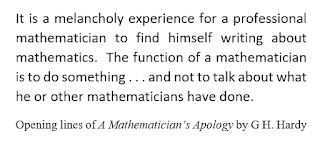Friday, February 18, 2011
Srinivasa Ramanujan
Thursday, December 30, 2010
Mathematicians are NOT entitled to arrogance
Thursday, May 25, 2023
EDGES -- as well as VERTICES -- are IMPORTANT!
G. H. Hardy (1877-1947) was a prominent English mathematician, well-known to mathematicians for his achievements in analysis and number theory -- and for his mentorship of the Indian mathematician, Srinivasa Ramanajuan. For most people outside of mathematics, Hardy is better known for his 1940 expository essay, A Mathematician's Apology; here are Hardy's opening sentences:
Wednesday, September 9, 2020
TEACHERS are important ... enlarge Hardy's view!
Outwitted by Edwin Markham (1852-1940)
He drew a circle that shut me out--
Heretic, rebel, a thing to flout.
But Love and I had the wit to win:
We drew a circle that took him in!
Thursday, November 14, 2019
Connecting mathematics to a larger world . . .
I will teach
mathematics
by punctuality
and perfect attendance.
In 1959, a Rede Lecture by C. P. Snow (1905-1980) famously identified two separate cultures -- the scientists and the humanists -- and these days what is often termed the STEM to STEAM movement is attempting to humanize the sciences by emphasizing the necessity of the arts in scientific study.
Monday, January 31, 2022
Math Communicators also are important
A posting early this month featured the noted Indian mathematician Ramanujan (1887-1920) who was mentored by the British mathematician G. H. Hardy (1877-1947). In addition to his important achievements in number theory and mathematical analysis, Hardy is well-known for his book, A Mathematician's Apology (Cambridge Univ. Press, 1969). Here are its opening lines:
A diamond's beauty
depends on reflection
of outside light.
Saturday, October 26, 2013
Two cultures
Two Cultures by Michael Bartholomew-Biggs
Graves claimed there isn't
much money in poetry:
and none vice-versa.
The first part stays true
if we replace poetry
by mathematics.
Tuesday, March 6, 2018
Linking mathematics to the rest . . .
Today my obtuse anger is rightly directed toward G. H. Hardy (1877-1947) and to the followers who have accepted his view -- in his 1940 treatise, A Mathematician's Apology -- that explaining and appreciating mathematics is work for second-rate minds. Despite his worthy achievements in number theory and analysis and his nurturing of Ramanujan, Hardy's words should not stand forth and belittle those who teach and explain and forge connections between mathematics and all the rest.
An wonderful and ongoing source of integration of mathematics with the arts is the Journal of Humanistic Mathematics -- and I invite you to go to the current issue and browse there OR go to this link for more than thirty pages of mathematical Haiku.
Monday, July 29, 2019
What is beauty? Is mathematics beautiful?
The article opens with this quote from A Mathematician's Apology (see p. 14) by G. H. Hardy: Beauty is the first test: there is no permanent place
in the world for ugly mathematics.
Tuesday, May 24, 2016
The Man Who Knew Infinity
Error is boundless.
Nor hope nor doubt,
Though both be groundless,
Will average out.
– J.V. Cunningham, from “Meditation on Statistical Method”
Often on my mind these recent days has been the film I saw last week -- "The Man Who Knew Infinity" -- and I invite you to follow these links to poetry concerning its central characters, mathematicians Srinivasa Ramanujan (1887-1920) and G. H. Hardy (1877-1947).






